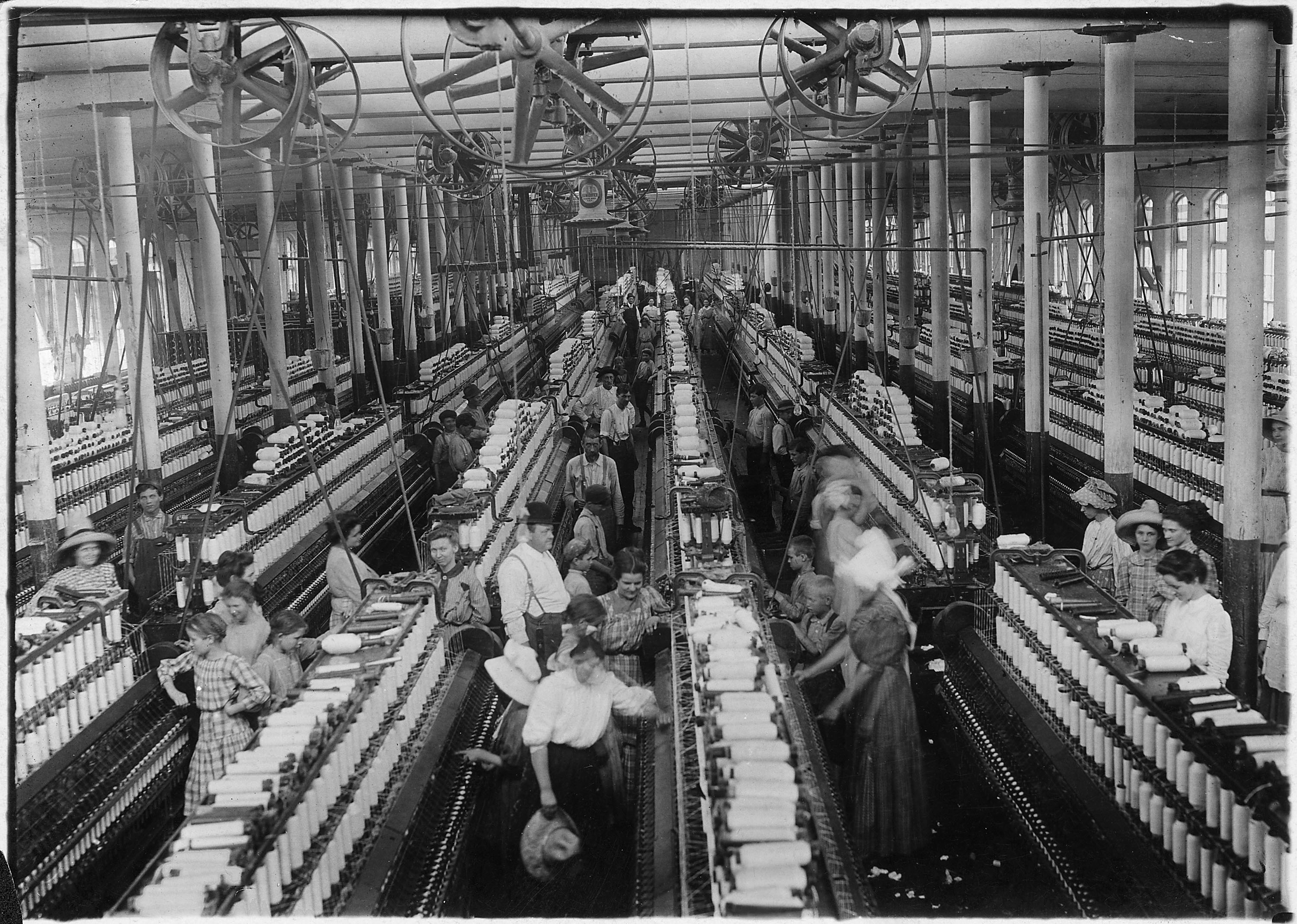A society, wrote Jan Patočka, is decadent if it encourages a decadent life, ‘a life addicted to what is inhuman by its very nature’. It is in this spirit that I want to explore the impact of technology on the human condition, and especially on work. Is technology making the human race redundant materially and spiritually – both as producers of wealth and producers of meaning?
For an optimistic answer to this question, let me turn to John Maynard Keynes. In his 1930 essay, ‘Economic Possibilities for our Grandchildren’, Keynes thought that technological progress would produce so much extra wealth that in about 100 years or even less, we would be able to reduce working hours to just 15 a week, or three a day. This process, he warned, was unlikely to be smooth.
We are being afflicted with a new disease … namely technological unemployment. This means unemployment due to our discovery of means of economising the use of labour outrunning the pace at which we can find new uses for labour. But this is only a temporary phase of maladjustment. All this means in the long run that mankind is solving its economic problem.
Ever since machinery became an active part of industrial production, redundancy has been seen either as a promise or a threat. The former has been the dominant discourse in economics, with redundancy seen as a transitional problem, confined to particular groups of workers, like the handloom weavers of early nineteenth century Britain. Over time, part of the displaced workforce would be absorbed in new jobs, part of it in the greater leisure made possible by improved productivity.
However, the fear of the permanent redundancy of a large fraction of the workforce – that is, its forced removal from gainful employment – has never been absent. The reason is that the loss of human jobs to machines is palpable and immediate, whereas the gain is indirect and delayed: an immediate threat versus a long-term promise.
The fear of redundancy has two roots. The first is people’s fear that machines will rob them of their livelihood; the second that it will rob them of their purpose in life. Sociologists stress the importance of work in giving meaning to a person’s existence. Economists, on the other hand, see work as purely instrumental, a means for buying things people want. If it can be done by machines, so much the better – it may free up people for more valuable pursuits.
It is not surprising that fear of redundancy surfaces whenever there is a burst of technological innovation. We are living through such a period now with the spread of automation. The headlines tell us that robots are gobbling up human jobs at an unprecedented rate – that up to 30 per cent of today’s work will be automated within twenty or so years. And the jobs themselves are becoming ever more precarious. So the old question is being posed ever more urgently: are machines a threat or a promise?

Interior of Magnolia Cotton Mills Spinning Room,1911. Photo source: U.S. National Archives via Flickr
Work in history
The western concept of work starts with the ‘disdain for work’ of the ancient world. Working for a living was despised. The good life was one devoted to politics in the Greek conception and to self-cultivation in the Roman. This ideal depended on slaves doing what we call work. Slaves, said Aristotle, were tools, and were tools by nature. Presciently, though, he speculated that one day mechanical tools might replace human tools.
The ancient contempt for work could not survive the decay of slavery, though vestiges of it have lingered in all aristocratic societies. This explains not just the high approbation of leisure by the elite of Keynes’s day, all whom were educated in the classics, but also the hostility to the ideal of leisure by the majority who associated with it not just the idleness of the rich, but with unemployment. The Chicago School notion that being out of work represents a ‘choice for leisure’ is the conceit of economists who have never experienced a day’s unemployment in their lives.
With Judaeo-Christianity the story gets more complicated. Work is the ‘primal curse’, the punishment by God for Adam’s sin of eating the forbidden fruit of knowledge; but at the same time it is a divine injunction to cultivate the fruits of the earth God has bestowed. Properly understood, God’s punishment was not to make people work, but to make work painful. Anthropology reflects the Biblical story in the idea of ‘original affluence’. Hunter gatherers needed everything around them, but they had everything they needed. Hunting was not work. Work enters human history with agriculture: ‘in the sweat of thy face shalt thou eat bread’ (Gen: 3:19). The monastic economy was built on the precept ora et labora: pray and work.
The productive unit in the pre-modern economy was the household not the factory: work and life were not yet separated. The division of labour was internal to the household. Unlike the ancients, the Middle Ages attached value to craftsmanship or ‘making things’. The medieval economy comprised farms and ‘manufactories’ in small towns which were little larger than villages. The professions had their origin in the urban guilds of skilled workers. Yet everyone was skilled in the sense that their work involved knowledge of all stages of production, not just tiny bits of it, as in Adam Smith’s pin factory. The nature of the work forced them to be ‘multi-tasked’. Associated with multi-tasking was multiple sources of income, with the ‘putting out’ system providing extra income for farmers in the fallow season.
The social and political structure was hierarchical: everyone had their place and their just reward in the scheme of things. Religion offered solace for earthly suffering. Universal insatiability, emphasised by economists as fundamental to human nature, was still in the future. In the late medieval world, commerce spread within Europe and to other lands, but it was still confined to the fringes of the economy. Temporary and permanent redundancy of the population there certainly was – but this was caused by harvest failures, wars, or plagues, not by competition from machines.
With the Enlightenment, the idea of work came to be associated not with the husbanding of nature, but with ‘overcoming’ it, the human project which has dominated western history ever since. It was human participation in this project, made possible by science, which was supposed to set the whole of humanity free, and not just that small minority of the wealthy and powerful. This was the democratic promise of work.
The particular form of progress which excited the eighteenth century imagination was the growth of wealth. ‘The end of production is consumption’ wrote Adam Smith. The more goods there were, the happier we would all be. The new human project spurred invention. The accumulation of wealth required machinery, since human work alone could not wrest more than a limited amount of produce from the earth. The Industrial Revolution changed the human link to work in a profound way. It replaced the artisan by the mechanic and home production by factory production. We have entered the age of capitalism, the economists, and economic motives.
The economists and machines
The fact that work was held to be the necessary means to enjoyment did not mean that it was itself enjoyable. The economists’ conception of labour shed any idea that it was natural or intrinsically satisfying. Work was not a curse, but it was a cost – the cost of consumption. For without work there would be no money to buy things. As Lenin was to put it with his customary bluntness: under communism Kto ne rabotaet, tot ne est: ‘Who does not work shall not eat.’
By the same token though, any reduction in this cost by the use of machinery opened up a brighter future: more output and therefore more money for less effort. The increase and improvement of machinery was inextricably linked both to the denial of satisfaction in work and to the promise of more and better consumption. Economists unanimously welcomed the dawn of the machine age.
As David Ricardo explained in the first edition of his Principles of Political Economy and Taxation (1817):
If, by improved machinery, with the employment of the same quantity of labour, the quantity of stockings could be quadrupled, and the demand for stockings were only doubled, some labourers would necessarily be discharged from the stocking trade; but as the capital which employed them was still in being, and as it was the interest of those who had it to employ it productively, it appeared to me that it would be employed on the production of some other commodity useful to society, for which there could not fail to be a demand; for I was, and am, deeply impressed with the truth of the observation by Adam Smith, that ‘the desire for food is limited in every man by the narrow capacity of the human stomach, but the desire of the conveniences and ornaments of building, dress, equipage, and household furniture, seems to me to have no limit … And, then, as it appeared to me that there would be the same demand for labour as before, and that wages would be no lower, I thought that the labouring class would, equally with the other classes, participate in the advantage, from the general cheapness of commodities arising from the use of machinery.
Two features of Ricardo’s argument have long been part of the economics of innovation: first, the treatment of supply (capital and labour) as malleable or fluid, based on the assumption of wage flexibility, geographic mobility and easy transferability of skills. Workers employed in producing stockings can be squeezed almost costlessly into the right shape for producing widgets. Technically, in other words, labour is treated as homogeneous. Second, the assumption of insatiability as the key motive driving forward the progress of wealth. In fact, Ricardo anticipates Lionel Robbins’s famous definition of economics as the science that studies human behaviour as a ‘relationship between ends and scarce means which have alternative uses’.
However, by the third edition of his Principles in 1821, Ricardo had somewhat changed his tune. The interval had seen the most intense period of the Luddite disorders. The Luddites, as is well known, were groups of English weavers who destroyed factory machinery – wide knitting frames and power looms – in the early days of the Industrial Revolution. They were eventually put down by the military, and their leaders hung or transported to Australia, despite Lord Byron making an eloquent speech in their defence in the House of Lords.
Scientific economic theory held the Luddite argument to be economically illiterate. But in 1821 Ricardo added a 31st chapter, entitled ‘On Machinery’, which was heavily influenced by the work of a now unknown economist, John Barton. In his Observations on the Circumstances which Influence the Conditions of the Labouring Classes of Society (1817), Barton argued that capitalists could just as well invest their profits in new machines as in additional labour. In doing so, he displayed a clear understanding of the principle of substitution between labour and capital, way ahead of his time.
Ricardo in effect accepted Barton’s argument. Two conclusions from his chapter 31 have been debated ever since: first, Ricardo’s statement that the opinion prevailing in ‘the labouring class, that the employment of machinery is frequently detrimental to their interests, is not founded on prejudice and error, but is conformable to the correct principles of political economy’. Second, that to the extent this opinion is true, ‘there will necessarily be a diminution in the demand for labour, the population will become redundant, and the situation of the labouring classes will be that of distress and poverty’. It was the notion of the population becoming ‘redundant’ which still strikes fear into those who dread the coming of the robots.
Ricardo did not think that redundancy was inevitable. Higher profits would increase saving, leading to more investment, which in turn would lead to more employment. This meant that ‘a portion of people thrown out of work in the first instance would be subsequently employed’; and if, as a result of the increased saving, the same gross produce was produced as before, there need not be any ‘redundancy of people’. Nor did he advocate slowing down the rate of mechanisation, ‘for if a capital is not allowed to get the greatest net revenue that the use of machinery will afford here, it will be carried abroad, and this must be a much more serious discouragement to the use of labour than the most extensive employment of machinery’.
It is interesting to see that Ricardo’s argument against ‘slowing down’ the speed of mechanisation is echoed in the most recent report on the future of work to have come out of the United States. According to the Council of Foreign Relations, America would lose its ‘best and brightest’ if it tried to hamper its own technological momentum.
The subsequent debate
Let me turn briefly to the economic debate after Ricardo. Central to this was the concept of compensation. The workers made redundant by machines would lose their livelihoods and perhaps even the satisfaction that their work had brought them; but they would be compensated by increased consumption, and the alternative employment which the increased demand for goods and services opened up.
Economists distinguish between ‘process innovation’ ( greater efficiency) , which would be ‘labour saving’, and ‘product innovation’, the introduction of a new good or improved quality of goods – which would increase the demand for labour. It is through product innovation driven by that unemployment is prevented from rising. This has been the standard argument.
The post-Ricardian discussion centred on the various forms of compensation which might be relied on to prevent the ‘redundancy’ of the population:
- Extra saving out of increased profits leads to extra ‘investment’.
- The general reduction in prices (which, as Ricardo recognised, would follow from process innovation and competition between firms) leads to additional demand for products, triggering product innovation and employment in new lines of production.
- Initial technological unemployment leads to a reduction in wages, but these reduced wages in turn increase demand for labour and induce a reverse shift back to more labour-intensive methods of production. The theory of wage adjustment remains an important part of contemporary partial and general equilibrium models.
How quickly these compensations come into play depends crucially on how fluid capital and labour are between occupations and regions. The introduction of labour-saving technology will initially decrease the consumption of workers who are made redundant. Unless there is a quick employment response, the cheapening of production will be swamped by a fall in aggregate demand, leading to a rise in unemployment. It was the essence of the Keynesian Revolution to deny the existence of the kind of equilibrating mechanisms postulated above – and certainly their quick operation.
Moreover, even if the delay in the adjustment of demand to supply is only a short-run phenomenon, a series of labour-saving innovations over time can add up to create long-term unemployment through a succession of these short-runs. Further, the price adjustment mechanism depends on the general prevalence of competition. If an oligopolistic regime is dominant, then the firm’s cost-savings may not translate into lower prices after all.
It is the sluggishness of adjustment to technological shocks that underpins the contemporary view that the benefits of automation are long-run, with ‘redundancy’ set to rise in the ‘transitional period’. But if, as a recent McKinsey Report acknowledges, the transition may last ‘for decades’, it is hardly surprising that workers are suspicious of this whole slew of compensation arguments.
As we know, Marx denied that any such compensatory processes were at work, either in the short-run or the long run. The story he told has no happy ending for the workers – at least under capitalism. Under the spur of competition, individual companies are compelled to invest as much of their profits as possible in labour saving – that is, cost-cutting – equipment. But increased mechanisation doesn’t benefit capitalists as a class. There is a temporary advantage for the first mover: ‘rushing down on declining average cost curves’ and annihilating the weaker firms on the way. But competition rapidly eliminates any temporary super-profit by diffusing the new technology. So the problem of keeping up the profit rate is not solved, only postponed.
The sequence Marx envisaged was this: competition forces mechanisation; mechanisation depresses the average rate of profit (because businesses extract surplus value from humans not machines); restoration of the rate of profit requires an increasingly large ‘reserve army of the unemployed’ – Ricardo’s redundant population. Thus, Marx was able to write that mechanisation ‘threw labourers on the pavement’. Marxist unemployment is essentially technologically-caused unemployment. The reserve army of the unemployed is temporarily absorbed in bursts of high prosperity, but its longer-term effect is to produce ever rising levels of pauperisation. Thus, for Marx, the sequence was exactly opposite to the classical story: mechanisation might create a febrile prosperity in short-run, but it would be at the expense of long-run degradation.
The distributional effects of technical change highlighted by both Barton and Marx have featured prominently in the economists’ discussion. Innovation can be labour-saving, capital-saving, or ‘neutral’ depending on its impact on the distribution of income between capital and labour. John Hicks developed the idea of induced innovation. Wage push by workers, threatening the profit rate, induces employers to substitute capital for labour. Most contemporary analysis treats automation as an outside shock, without understanding that it is driven by changes in the relative cost of labour and capital.
The above is the briefest sketch of a complex technical debate. What one can say is that economic theory does not provide a clear answer about the final effect of technological progress on employment. The best conclusion we can salvage from it is that the impact of technology on jobs depends on the balance between process and product innovation, and factors such as the state of demand, the degree of competition, the relation of forces between capital and labour, and the potential for increasing human capital.
Lessons of history
What does history tells us? The Luddites were undoubtedly right about their own trade – handloom weaving. Whereas spinning had been mechanised in factories, weavers were primarily using a hard-loom which was operated on a domestic basis up until after the Napoleonic wars; in other words, they still owned their means of production. Wages in weaving were very high, as it was a skilled craft. It was not until the early 1840s that the number of power looms in production exceeded the number of hand-loom weavers.
The introduction of the power-loom had three primary results: it concentrated the weaving aspect of cotton production in the factories, it led to the displacement of the hand-loom weavers, and it destroyed the wages they had received. The displacement of labour from the spread of power looms brought down the wages of the hand-loom weavers from 23 shillings a week in 1800 to 6 shillings a week in 1830. Nassau Senior advised them to ‘get out of that branch of production’. They did: 240,000 handloom jobs disappeared between 1829 and 1860 as power looms surged ahead.
What about the larger picture?
Between 1800 and 1915, the population in Europe (minus the Russian empire) grew from 152 million to 315 million. Between 1890 and 1915 (the period of maximum emigration), about 40 million people left Europe for the lightly-populated New World. Had this vent for surplus population not existed, Europe might well have experienced some population redundancy in the nineteenth century.
The extra wealth brought by machines enabled voluntary retirement from the labour force, a possibility discounted by the earlier generation of economists, fixated on scarcity. From the mid-1800s, hours of work started to fall from a peak of 60–70 hours a week to about 55 hours by 1914, and then further throughout the twentieth century, as workers took out some of their income gains in greater leisure. The first consequence of wage rises is to increase hours of work in expectation of more consumption; but when people are sufficiently sated they reduce their work effort. Something like this seems to have happened.
Through various mechanisms, then, the nineteenth century did not see a general ‘redundancy’ of the population. Machinery enabled the economy to support a population that doubled in size at a substantially higher real income. Despite the increase in population, labour’s share of GDP remained constant throughout the Industrial Age. A degree of redundancy is reflected in emigration figures; a substantially larger degree of voluntary redundancy in reductions in hours of work. Economists were surely entitled to say that such losses as were incurred in the meaning and quality of work and in the more unsettled conditions of life were more than compensated – in the long-run – by the vast gain in material wellbeing. Overall, the Malthusian bogey was obliterated so completely – in the West at least – that the dismal science became the cheerful science.
Relevance for today
We know that the speed and power of mechanisation had accelerated dramatically. The decisive new advance has been in automated technology and the digital economy, which thrusts mechanisation far deeper into the world of human labour. It is difficult to grasp enormity of changes going on before our eyes, we don’t have enough distance from them. But history and theory can offer some guide.
The theorising provoked by automation is in some respects different from the earlier response to mechanisation. It can be summed up in the notion of ‘complements’. This holds that while one effect of automation will be to displace some workers by machines – as in self-driving vehicles – a more powerful effect will be to enlarge the human capacity to complement or work with machines. Thus, the new production processes are best viewed as hybrid, using both human and machine labour. A favourite example is the chess match. A good computer can beat the best human chess player. But the best computer which combines with the best chess player can beat the best computer. Humans will continue to ‘add value’ to machines. There is no need for them to race against machines, a race they are bound to lose. Rather they will race with machines to an ever more glorious future. This theory, as we can see, replaces the old demand-side story of compensations, with a supply-side story based on the stimulus machinery gives to the development of human capital.
But there are big flaws in the two components of the optimistic view: compensations and complements.
The two major weaknesses of the compensation theory is, first, that it accepts that for most people work has no value except as a means to consumption; and second, that it assumes insatiability, or permanent discontent with what is, whether natural or manufactured. Its vista is consumption without end.
The flaw in the theory of complements lies in its vast over-estimation of human capacity. There is no reason why human mental capacity in general should increase at the same rate as machine mental capacity. A minority will be able to race with the machines in the knowledge economy. But a substantial fraction will be ‘left behind’. What is to happen to them? Already, the ‘left behind’ symptoms, and reactions to them, can be seen in increasingly precarious employment, stagnant or even falling wages, and populist protests against both automation and one of its chief agents, globalisation. Even if these distempers are only temporary effects of the displacement of labour, optimists themselves concede that the transition period may last decades.
Thus, the idea that a supply shock like automation will automatically set in motion acceptable compensatory demand or complementary supply responses seems to me to be pure delusion. There will, of course, be responses, but they are likely to be highly disruptive, even destructive. Given this, policy must pay much more attention to correlating the rate of change with the capacity of human society to absorb it. This will include slowing down the speed and spread of automation, ensuring its material fruits are equitably distributed, maintaining an adequate level of demand, and providing income guarantees to offset growing precariousness in the job market as robotisation presses wages downwards and eliminates jobs.
This seems to me to be as much as policy can do. None of this, though, addresses the question raised by Patočka: how humans can be enabled to ‘feel at home’ in world governed by an inhuman and, if not intentionally, inhumane, logic.
This text is based on Robert Skidelsky’s Institute for Human Sciences (IWM) / Jan Patočka Lecture held on 25 April 2018 in Vienna. A shorter version appears in the Autumn 2018 issue of the IWMPost.







